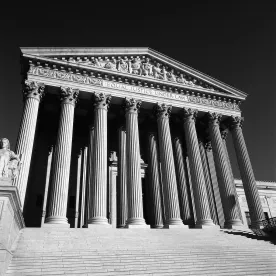On June 6, 2011, the U.S. Supreme Court issued a unanimous opinion in Erica P. John Fund, Inc. v. Halliburton Co., holding that a plaintiff is not required to prove “loss causation” to obtain class certification in a securities case. The Supreme Court’s decision eliminates a major hurdle for class action plaintiffs in the Fifth Circuit, and it will likely result in an increase in securities litigation filings within the Circuit.
The Loss Causation Doctrine
Traditionally, the key battleground in securities class actions has been at the pleading stage. Courts have stringently applied federal pleading requirements to prevent unmeritorious actions from moving forward. But if a plaintiff could survive a motion to dismiss, there were relatively few hurdles to obtaining class certification.
The Fifth Circuit, however, erected an additional barrier to plaintiffs at the class certification stage. Since 2007, the Fifth Circuit has required plaintiffs to prove "loss causation”—i.e., proof that the alleged fraud actually caused the plaintiffs’ losses—in order to certify a class in a securities case.
Loss causation has been a hot issue in securities litigation since the Supreme Court’s 2005 decision in Dura Pharmaceuticals, Inc. v. Broudo. The element of “loss causation” is distinct from the separate element of “reliance.” To establish “reliance,” the plaintiff must prove that the alleged fraud caused him to purchase or sell the disputed security. To establish “loss causation,” the plaintiff must prove that the alleged fraud proximately caused his economic loss. In Basic v. Levinson, a seminal 1988 decision, the Supreme Court held that reliance may be presumed for a plaintiff who purchased or sold a company’s securities in an efficient market (thus establishing the well-known “fraud-on-the-market presumption”). Seventeen years later in Dura, the Court held that a plaintiff must prove his losses were caused by the alleged fraud, as opposed to external events such as adverse market conditions.
After Dura, the Fifth Circuit issued a series of decisions that gave teeth to the “loss causation” doctrine as a defense to securities class actions, but also conflated loss causation with reliance. Beginning with its decision in Oscar Private Equity Invs. v. Allegiance Telecom, Inc., the Fifth Circuit repeatedly required plaintiffs to prove, at the class certification stage, that the defendants’ alleged misstatements (as opposed to other contemporaneous disclosures or market forces) independently moved the market before they were entitled to invoke Basic’s fraud-on-the market presumption of reliance. This created a significant burden for plaintiffs, especially where multiple disclosures were made simultaneously, and it had a chilling effect on securities cases in the Fifth Circuit.
Not surprisingly, the plaintiffs’ bar has roundly criticized the Fifth Circuit standard. But so have many others, including other circuit courts. In August 2010, Judge Easterbrook of the Seventh Circuit expressly disapproved of the Fifth Circuit’s “go it alone approach.” The Second and Third Circuits also have rejected the Fifth Circuit standard. No other circuit court has agreed with the Fifth Circuit's approach. Earlier this year, the Supreme Court agreed to hear the Halliburton case to resolve the split among the circuit courts.
The Halliburton Case
The Halliburton plaintiff sued the company for alleged material misrepresentations regarding its potential liability in asbestos litigation, its accounting of revenue in its engineering and construction business, and the benefits of a merger with now-defunct Dresser Industries Inc. The plaintiff alleged that Halliburton’s share price declined when the company subsequently corrected the alleged misstatements, and they filed a motion for class certification on behalf of all Halliburton shareholders.
The district court denied the plaintiff’s class certification request, finding that the plaintiff had failed to establish loss causation with respect to any of its claims. The district court noted, however, that it would have certified the class but for the Fifth Circuit’s “stringent loss causation requirement.” The Fifth Circuit affirmed the district court’s decision, emphasizing that the plaintiff had failed to prove “loss causation, i.e., that the corrected truth of the former falsehoods actually caused the stock price to fall and resulted in the losses.”
The Halliburton plaintiff filed a petition for writ of certiorari, asking the Supreme Court to address what it called the Fifth Circuit’s “substantial and unprecedented burden” on securities class action plaintiffs. The petition argued that the Fifth Circuit’s holding is in direct conflict with principles adopted in other circuits and federal district courts, as well as the Supreme Court’s holding in Basic.
On June 6, 2011, in a unanimous opinion authored by Chief Justice John Roberts, the Supreme Court soundly rejected the Fifth Circuit’s approach to class certification in securities cases. The Supreme Court found that the Fifth Circuit’s loss causation requirement is “not justified by Basic.” Chief Justice Roberts explained that the Fifth Circuit approach “contravenes Basic’s fundamental premise – that an investor presumptively relies on a misrepresentation so long as it was reflected in the market price at the time of his transaction. The fact that a subsequent loss may have been caused by factors other than the revelation of a misrepresentation has nothing to do with whether an investor relied on the misrepresentation in the first place, either directly or presumptively through the fraud-on-the market theory. Loss causation has no logical connection to the facts necessary to establish the efficient market predicate to the fraud-on-the-market theory.”
The Impact of Halliburton
Halliburton will have significant impact in the Fifth Circuit. The Supreme Court has removed a major hurdle for securities plaintiffs. But the issue of loss causation at the class certification stage may not be dead. It may simply be reframed.
Interestingly, Halliburton distanced itself from the Fifth Circuit’s case law in its arguments before the Supreme Court. Halliburton argued that if a defendant successfully rebuts the fraud-on-the-market presumption, then the plaintiffs are required to prove that the alleged misstatements had a price impact upon the stock price. This approach is consistent with opinions from the Second and Third Circuits. While acknowledging the argument, the Supreme Court refused to express an opinion on this proposed framework.
Following the Supreme Court’s decision, Halliburton issued a press release expressing its confidence in victory at the Fifth Circuit after remand. Halliburton noted that the Supreme Court had not addressed “the question of whether proof that alleged misrepresentations had no impact on the stock price rebuts the presumption of reliance and prevents class certification,” and it signaled that this would be a principal defense going forward. If the Fifth Circuit accepts this argument—that plaintiffs must prove price impact if the Basic presumption is rebutted—Halliburton may have done little more than shift the burden of proof, and loss causation will remain a substantial hurdle for class certification in securities litigation.
While the impact of Halliburton on securities class actions remains uncertain, the issue of loss causation at the class certification stage is likely to be litigated for years to come. This may be the newest battleground at the Fifth Circuit.
Related documents:




 />i
/>i

